A definitive guide to mobile marketing
We live in an increasingly smartphone-centric world today, with more mobile phones than humans on the planet. In fact, an impressive 80% of global internet users today own a smartphone (Source: Global Web Index).
This growing smartphone traction has changed the way companies do business: it’s made mobile marketing an intrinsic part of marketing campaigns. The aim may be brand building, boosting sales, or increasing engagement – mobile marketing is now critical to a company’s consumer outreach campaigns.
Updated on Nov 12, 2020
Marketers need to be where their customers are. And today, most of them are on their smartphone devices. Taking cognizance, mobile marketing strategies are targeted at people on the go. It provides users with location-specific and hyper-personalized information – that is, the right information, at the right time.
In today’s mobile-driven era, if marketers are not implementing mobile-dedicated marketing strategies, then they’re losing key ground to competitors. It’s time to adapt or perish. Smartphones have become a worldwide phenomenon and businesses have to find ways to use them to market their products. Whether they want to build their brand, boost sales or increase customer conversions, they have to get on to the fast lane of mobile marketing.
In this blog, we look at why mobile marketing has emerged as the king of marketing strategies and how to create a winning game plan to sell your products via smartphones.
What is Mobile Marketing?
Mobile phones have revolutionized the way customers engage with a brand and how companies reach out to their target audience. They’ve become a ubiquitous device: people visit websites, check emails, shop, and socialize on their smartphones. Putting your business where your consumer is – always on the go – is what defines mobile marketing.
Mobile marketing has brought such a massive change in the way companies reach out to their consumers, that some marketers believe it’s not just a mere complimentary update in desktop marketing strategies – it’s a paradigm shift.
Essentially a subset of marketing, mobile marketing takes a marketing strategy – be it the message, design or the target consumer – and optimizes it for delivery on a mobile device. The platforms that a marketer uses – social media, emails or text messages – depends on where their users spend the most time and the kind of content they consume. Mobile marketing puts a brand in direct contact with their consumer.
Check out our interactive product tours
Why Mobile Marketing Is the Way to Go for Marketers
The straight answer is: Mobile marketing is the only logical way to connect with an audience that keeps their mobile devices within arm’s length, 24/7.
Companies are realizing that customers have changed the way they consume digital content – they’ve switched from desktop-based to mobile-based usage. Also, mobile marketing uses geo-location and app-activity tracking to create personalized marketing campaigns, resulting in increased click-through rates and conversions. So, the earlier marketers start reaching out to consumers on their smartphones, the more business sense it makes.
Let’s look at the top USP’s of mobile marketing:
- Adds a personal touch: Reaching your audience on their mobile device creates a one-to-one connect in many ways. For instance, marketers can create personalized web pages based on a user’s behavior. They can tailor and send super-personalized push notifications. Or they can offer special coupon codes for purchases made from a mobile device.
- It’s instant and effective: Companies can reach their audience instantly and constructively. The numbers say it all: text messages have an open rate of 99%, as compared to a 6% open rate for email marketing.
- It’s high on engagement: A mobile-optimized marketing strategy engages customers effectively by creating a personalized and timely brand interface. Today, people spend a lot of time on their phones and become habituated to using certain apps or websites. This makes them loyal users and more likely to complete a conversion, as compared to, maybe, an email user. Conversion rates and click-through rates are always higher on mobile apps and websites, than desktop devices. Since mobile marketing is all about personalized engagement, users share their contact details only with companies they want to engage with. So they are prepared to view your promotions. Result: high click-through rates.
- Location-based advantage: Localization takes personalization to a whole new level. Mobile devices allow companies to know their user’s locations. This means they can send personalized and effective communication to specific user segments.
- Makes brands search engine friendly: Search engines give a higher search ranking to companies whose websites are mobile-friendly.Over 60% of Google searches happen on mobile devices. To get full advantage of this high search percentage, search engine optimization (SEO) should be a major part of mobile marketing strategies – like it is with larger digital marketing strategies.
- Helps you go viral with ease: Your content can be shared faster and more easily and can go viral in quick-time. Mobiles are portable devices. This makes your advertisements and communication portable as well – accessible on the go.
- Include gamification into your marketing strategy: A huge chunk of mobile users play games on their devices. This makes smartphones a great medium to introduce gamification into your marketing strategy. Be it Insider’s Wheel of Fortune gamification tool or Scratch a Coupon, you can instantly draw your users’ interest with exciting games.
What the Statistics reveal about Mobile Marketing
If you want to get your mobile marketing strategy right, you first have to know the numbers. And there are hard numbers galore to back the euphoria behind this new-age marketing platform. Let’s look at some mobile marketing statistics.
First, let’s take a macro view of how mobile devices have stamped their presence on a user’s web-universe:
- In April 2019, the global mobile population was 4 billion unique users. That is about 40% of the world’s population.
- People spend 2 hours and 51 minutes, on average, per day, on their mobile devices.
Marketers must note that speed and creating the right user experience are critical while formulating a winning mobile marketing strategy. Here’s why:
- A load time of 5 seconds or less guarantees 70% longer viewing sessions. Slow loading images put off more than 50% of users.
- Companies can lose 9 out of 10 customers because of a lower mobile-friendly experience. Also, Google is likely to remove websites from search engine ranking pages (SERP) if they are not mobile-friendly.
- 50% users who have a poor mobile experience have a negative view of the brand and business as a whole.
(https://www.ukwebhostreview.com/blog/smartphone-statistics/)
How to Create a Winning Mobile Marketing Strategy
To make a mark in the digital universe, marketers must have a well-defined mobile marketing strategy. For this, they must first understand how consumers use their smartphones.
Mobile users usually check their devices in short, but frequent, bursts. It could be while commuting to work on the tube, during a coffee break, or before going to bed. This holds an important lesson for marketers: keep your content sharp, clear and contextual. Besides, companies must research and redesign their marketing material to optimize their sales funnel.
Let’s run through a step-by-step guide on creating a top-scoring mobile marketing strategy:
1.Create a buyer persona
Marketing is about being contextual – reaching the right consumer with the right message. This makes it important to understand the mobile usage patterns of your consumers and segment them into relevant clusters.
Traditional segmentation categories – like demographic, behavioral or geographic – are no longer considered effective as they divide customers on surface-level similarities.
Instead, create incisive category clusters like VIP users, premium users, or deal seekers. Using Insider’s predictive segmentation engine for mobile apps, you can also build advanced segmentation like users who have a Likelihood to Purchase, Likelihood to Churn or Likelihood to Uninstall.
2. Set a goal
Clearly define what you want to gain from your mobile marketing strategy. Do you want to generate more conversions? Grow your database? Increase traffic to your website? Example: If you want to start a text message campaign, an effective goal would be to create an opt-in database.
3. Fine-tune your user’s mobile experience
Screen size limits the experience and navigation of a user. It’s important to create content that can be optimally viewed on a small screen. Here are some golden rules to follow:
- Be brief, be bold: Keep the content short, go for bold headlines.
– Create short forms: If you’re asking your users to fill out forms, keep them short. No one likes to type long-winding information on a phone screen.
– Add a big CTA button: CTA buttons are an integral part of any marketing strategy. On the mobile, it’s important for marketers to create CTAs that are completed in a few, quick steps. Also, keep it large so it’s easy to tap on.
– Customize your content as per user preference: Personalize content, so that it’s contextual and relevant for your users.
– Create a seamless navigation flow: Make sure users can navigate your app or mobile web page in a glitch-free way, with a minimum clicks.
– Test, test, test: Whether it be text, visuals or the navigation flow, do not assume what your users will prefer. Always test before going live. It’s a sure-shot way to create the best-in-class experiences.
4. Create a mobile responsive webpage
The flow and design of your webpage should be dedicated to mobile requirements. Make sure your content is easily viewable on a mobile device. Also, speed is of essence, as user attention spans are shortening. So you have to ensure:
– As some devices take a notoriously long time to load image-heavy web pages, create mobile-friendly landing pages that minimize loading time.
– Make sure your site works fast. If it doesn’t, a majority of your consumers will move to the next site.
5. Create an effective engagement strategy
Now that your mobile platform is up and running, it’s time to engage with your users. You can use various channels to communicate with your customers:
- User onboarding: Guide your users to onboard onto your mobile app seamlessly and make the desired conversion actions. Example: If you are a banking service provider, tailor the navigation flow in a way that users easily arrive at the credit card application page. If you are a fitness company, induce your users to opt for a minimum number of workout sessions. Or if you are an eCommerce retailer, incentivize your customers to make a purchase within their first week of onboarding.
– Send push notifications: They can be reminders, discount offers, product advertisements or provide information about your brand.
– Use geo-fencing for location-based marketing: When a mobile user crosses a virtual geo-fence, send him a push notification. Geo-fencing minimizes bounce rates as relevant ads are provided to a segmented audience. Geo-fencing also enables marketers to provide a seamless shopping experience, by combining online and offline channels. Example: Click-and-collect or `Buy online, pick up in-store’ shopping. This allows customers to order good’s from a store’s website and collect them from a local branch, thus saving time and shipping costs.
– Embrace social media platforms: Most traffic on social media comes from mobile devices. This makes it a perfect platform to interact with your customers, advertise and increase brand awareness.
– Onsite personalization: Personalize your mobile web page as per a user’s interests, using banners or tailor-made menu bars. This will increase conversions and click-through rates.
– Send gamified In-app notifications: They will direct users towards their points of interests using attractive gamification options, to increase app usage, retention and lifetime value.
When should a Company invest in a Mobile App?
It’s never too soon to jump onto the mobile app bandwagon. Providing positive mobile experiences has become critical for marketers. Research by Think with Google found that people who have a negative mobile experience are 62% less likely to buy from that brand in the future.
Companies have a compelling reason to invest in a mobile app when:
- You want to take customer engagement to a whole new level: Mobile apps are an effective way to garner new customers and boost sales, as they allow users to shop from anywhere, at any time.
- You want to speed up your customer experience: Mobile apps are faster than desktops, as many processes are streamlined. For example: Apps can use fingerprints instead of passwords to login.
- You want to be an on-the-go-marketer: You want to promote your product at any time, any place.
- You want to give your brand enhanced visibility: As users scroll through their mobile device, they’ll see your company logo on your app every time. Also, you can send push notifications if they’re not opening your app frequently. This way, you stay in a user’s short term memory.
How Insider can add Value to your Mobile Marketing
For a user, a mobile web experience and a desktop experience are as different as chalk and cheese. The polarity ranges from a difference in screen size, content organization to tricky keyboards on mobile devices.
Since 62% of user traffic comes from mobile web platforms today, it has become increasingly important for marketers to design websites for mobile use, and not merely desktop browsing. This will ensure that users have a seamless web experience on their smartphones, and therefore, improve click-through rates.
Insider’s vision is to be a mobile-first company and it has a first mover advantage in this segment. Let’s trace Insider’s journey to become a pioneer in providing the most relevant mobile-focussed marketing tools to marketers:
- Insider was the first platform to provide AMP (Accelerated Mobile Pages) and PWA (Progressive Web Apps) support to mobile marketers.
- Sending pop-ups to users when they were exiting a webpage was a service available only for desktop websites. Insider became the first company to launch an Exit Intent tool for the mobile web.
- Engaging users with targeted Social Proof messaging happened only on the desktop web. Insider changed it with the world’s first Social Proof tool for mobile apps.
- The desktop web has tools galore to build stories to promote products. Insider was the first platform to launch its story-building tool – InStory – for the mobile web.
- Insider was the first to launch a Mobile Web Recommendation Engine, which recommends products to users based on exclusive mobile app data on their behavior. Insider’s access and use of specific mobile data makes it stand apart from its competitors. All other recommendation engines in the market use web data to create recommendations for mobile apps.
- Insider’s gamification tools are the first to come with mobile web templates.
- For a 360-degree feedback and data-gathering loop, Insider has created Survey and NPS templates for the mobile web.
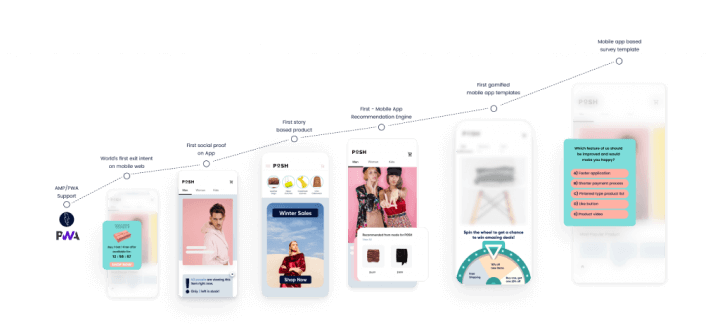
Designed specifically to create a seamless mobile web experience, Insider’s products come with templates that are easy to edit and integrate. When it comes to providing products for the mobile web and app, the choice is usually between providing a template or creating a fully designed product. Insider chose the template route, for two main reasons:
- Screen resolution differs from device to device.
- Placement of elements in the design must be done with respect to the nature of the product being marketed and the expected consumer response.
Let’s encapsulate the products that are part of Insider’s Mobile Web Platform Suite:
- Survey for Mobile Apps
This product helps companies understand their user’s needs, requirements and garners feedback on a product or service on mobile applications. It comes with a long set of predefined questions that marketers can use to create a multi-page survey. User’s answers are recorded at every step of the survey, so they can choose to answer the survey partially or wholly.
Stop guessing with loud and rowdy internal discussions and be bold and ask directly to your customers what they feel, how they experience.
After you reach the adequate data, as a marketing manager, you deliver the briefing from the customer. Eventually, you optimize the app based on the user data. It is not the end, segmenting the users according to their selection enables you to communicate with them after the required development. That type of communication like “you asked, we shipped, now our app is better thanks to your feedback” will create a lovebrand and full cycle feedback loop.
You can also ask and learn the preferences of your customers through your products or services. For example, if you are running a travel application, asking users what is going to be the next destination that you dream for this summer helps you tailor the engagement strategy based on different user answers.
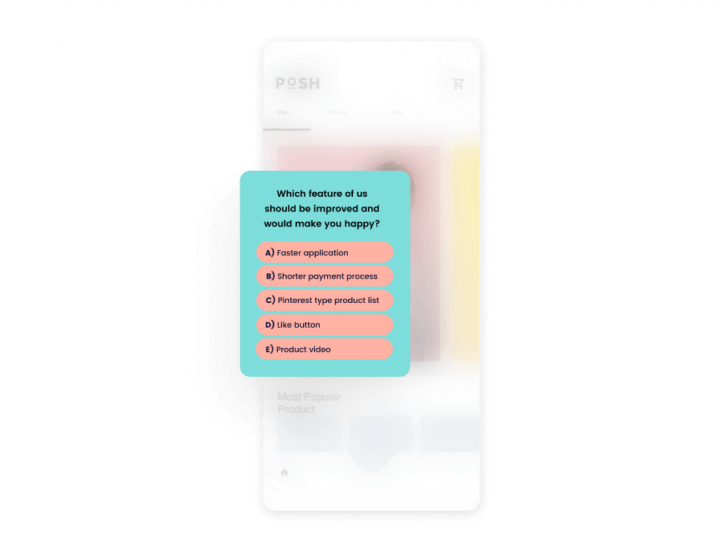
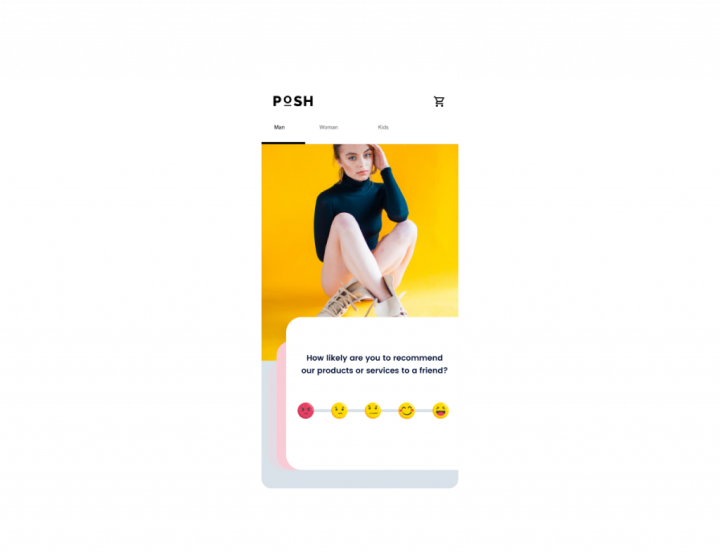
2. Social Proof
FOMO (Fear of Missing Out) is a critical trait that influences purchase behavior. Users are influenced by other people’s shopping experiences. Insider’s Social Proof messaging creates a sense of urgency around a product. It works in two ways letting users know about the popularity of a product and informs them that stocks are running out.
Let’s take the example of an eCommerce retailer. The company has launched a new pair of running shoes. To grab user attention, it posts a banner on its product page: “500 people have viewed this item.” This lets consumers know the product is garnering high interest.
What if a consumer still isn’t convinced? The company updates the banner to inform the user that the product is getting sold out fast: “Only 25 items left in stock,” reads the follow-up banner. This double-edged urgency propels the user to make a purchase.
Social Proof messaging is well-suited for companies across verticals. Let’s look at how a publishing company can use it to the best effect. The company has published a travel article about an off-beat destination. To attract readers, it posts a banner: “1,000 readers have read and liked this article.” Viewership shoots up multiple-folds.
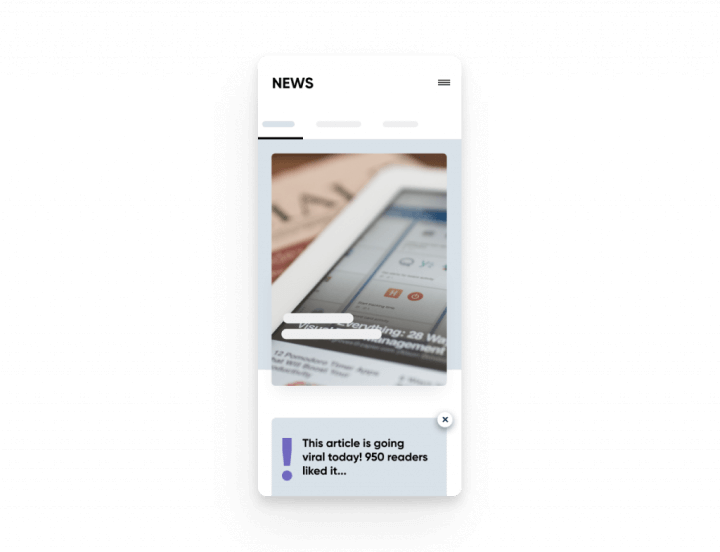
3. InStory
Creating personalised stories provides an immersive experience to engage and convert mobile web audiences, making a big impact on a small screen. With just a few taps, this Instagram-like feed builder enables you to showcase…
Companies can use InStory to publish announcements, promotions, new services or events, just like Instagram Stories. It’s an effective tool for companies that rely on their mobile websites to reach customers. Using stories, they can take their visitors on a visual tour, describing the journey behind their product or campaigns.
How does InStory work? Let’s take an example.
When a high-end shopper landed on a beauty retail mobile website to purchase a body cream, she got to view additional products and information that were personalized to fit her interest. She viewed hot vitamin-based items before, read customer reviews multiple times to learn about the item. It turned out to be an optimized mobile shopping experience, which encouraged her to purchase more. Additionally, providing an option for customers to easily review social media post related to the product can offer further insights and build trust among potential buyers.
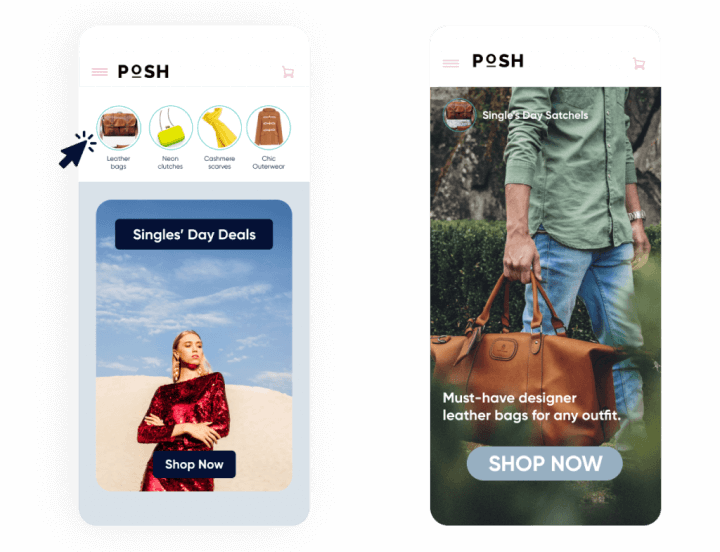
4. Smart Recommender
Smart Recommender helps marketers create recommendation feeds in any page type, using relevant feeds. When it comes to grabbing consumer data, the mobile app works differently from the desktop web. Mobile app platforms generally do not have enough page depth to provide accurate product recommendations. Also, the user interface doesn’t have sufficient space to promote products.
Working around these obstacles, Insider’s Mobile App Smart Recommender platform can directly collect data from app users’ behavior to offer accurate recommendations to users. To promote products, it uses diverse UI options like inline placement or model windows.
Smart Recommender provides multiple benefits to marketers:
- It helps increase conversions and conversion rates by providing personalized recommendations.
- Relevant recommendations result in further product discovery, increasing engagement rates and click-through rates.
Let’s look at how a fashion brand uses Smart Recommender to boost conversions on its mobile app. When a user logs in for the first time, the tool records her search behavior. When she returns to the retail site a second time, to purchase the most trending product, the tool uses her mapped browsing history to encourage her to add the most popular trendy shirts and a jacket which goes well with the trendy products to her cart as well.
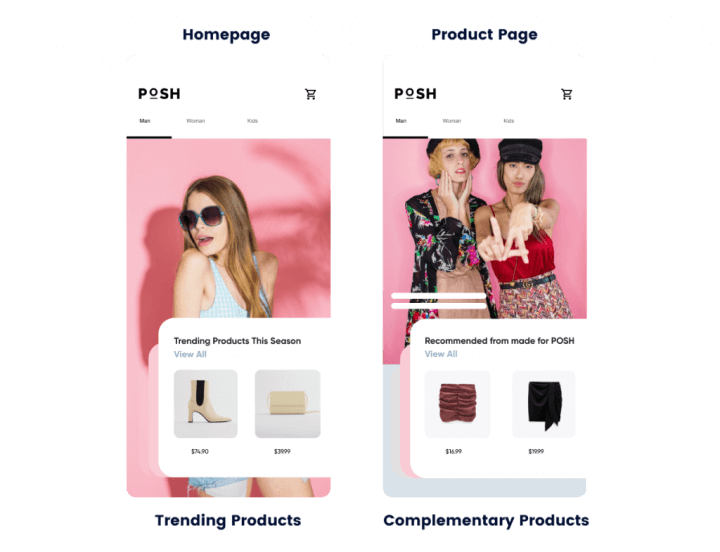
5. Mobile Web Exit Intent
Mobile marketing may be skyrocketing, but conversion rates and cart abandonment remain a challenge for companies. A Smart Insights report reveals conversion rates are 4% and abandonment rates 50% on mobile websites. How do marketers check this trend? One way is to catch visitors who are about to leave your page and engage them using enriched exit intent notifications.
Insider has created a first-of-its-kind Web Exit Intent tool that delivers relevant exit intent notifications to specific micro audiences. What exactly do these algorithms do? This AI-powered predictive technology uses specific touch behaviors (example: double-tapping the mobile browser to switch between tabs or an upward scrolling speed that indicates declining interest) to let marketers anticipate a user’s future action on a webpage. If the tool detects an intention to abandon the page, it sends a relevant and personalized message encouraging the user to stay on the site.
Let’s illustrate with an example. An eCommerce company has launched its mobile website and is wooing visitors. The company doesn’t want to lose customers who land on its mobile webpage. Using Insider’s Web Exit Intent, it keeps tabs on a user’s actions on its page. At the first indication that the user may leave the page, the retailer sends a pop-up notification, with offers of free shipping or money-back guarantee. The user takes up the offer, after sharing his email id. The retailer, therefore, builds his user database as well.
Mobile Web Exit Intent serves many goals for marketers:
- Increases conversions on the mobile web.
- Builds customer loyalty.
- Helps retailers build their user database.
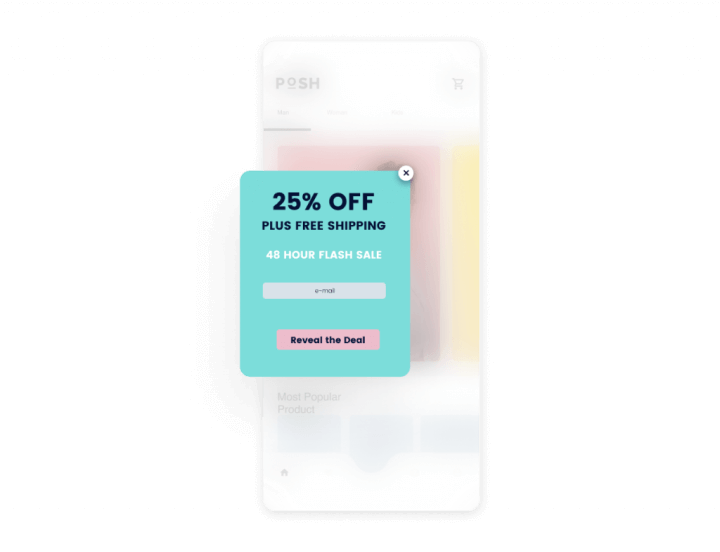
6. Gamification tools for the Mobile Web
There are many users who visit a mobile web page once and then never return to convert. They simply sink into oblivion and mobile marketers are unable to reach them. Insider’s gamification tool, Template Store – which comes with various mobile app templates such as Wheel of Fortune, Scratch the Coupon, Countdown… many will come… – helps convert app visitors into leads, who marketers can then nurture into loyal customers.
For example, Wheel of Fortune works just as the name suggests: when visitors log onto a mobile app, they spin a wheel, enter their contact details and stand a chance to win an array of deals and offers.
The Wheel spins a win-win deal for both the company and the consumer. Marketers can grow their customer database in quick time. Going forward, they can engage with these users and convert them into leads. For shoppers, the deals and offers are too lucrative to turn down.
Let’s take an example. It’s the holiday shopping season, and an e-commerce retailer is expecting a sharp increase in customer traffic on its mobile web page. The company also realizes that many of these visitors will be one-time deal-seekers, who are lured by the gainful discounts, and may never return to shop again once the sale season is over.
The retail company wants to convert these deal-seekers into future leads. It opts for a gamification tool, to use a fun way to engage the buyers and get them to provide their contact details. Using the Wheel of Fortune, shoppers spin a wheel, feed in their contact details and win a discount or a free holiday package. There’s no way users are going to turn down such a tempting offer. The marketers, in turn, get to build their database.
Gamification tools are a great way for marketers to:
- Engage users in a fun way.
- Build their customer database, generate new leads and increase conversions.
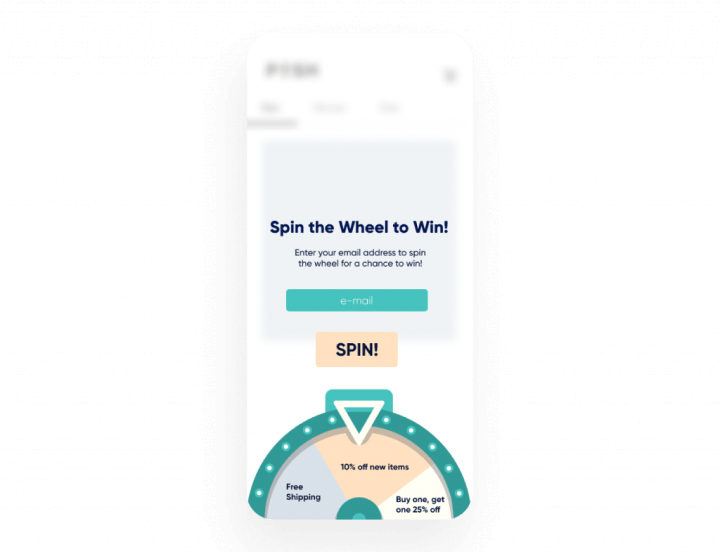
Conclusion
As consumers increasingly turn to their mobile devices to shop, communicate, and socialize, the need for marketers to create a clear-cut and exclusive mobile marketing strategy has increased by leaps. In doing so, marketers must remember that the key to reaching users effectively on their mobile devices is to deliver your marketing message quickly, clearly, contextually, and on the right platform at the right time.



















